国际课程IGCSE剑桥物理 chap18
igcse 物理大纲(完整资料).doc
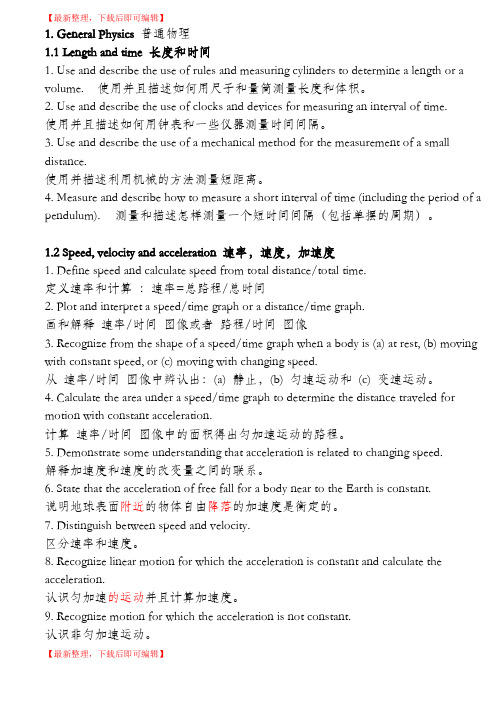
【最新整理,下载后即可编辑】1. General Physics 普通物理1.1 Length and time 长度和时间1. Use and describe the use of rules and measuring cylinders to determine a length or a volume. 使用并且描述如何用尺子和量筒测量长度和体积。
2. Use and describe the use of clocks and devices for measuring an interval of time.使用并且描述如何用钟表和一些仪器测量时间间隔。
3. Use and describe the use of a mechanical method for the measurement of a small distance.使用并描述利用机械的方法测量短距离。
4. Measure and describe how to measure a short interval of time (including the period of a pendulum). 测量和描述怎样测量一个短时间间隔(包括单摆的周期)。
1.2 Speed, velocity and acceleration 速率,速度,加速度1. Define speed and calculate speed from total distance/total time.定义速率和计算:速率=总路程/总时间2. Plot and interpret a speed/time graph or a distance/time graph.画和解释速率/时间图像或者路程/时间图像3. Recognize from the shape of a speed/time graph when a body is (a) at rest, (b) moving with constant speed, or (c) moving with changing speed.从速率/时间图像中辨认出:(a) 静止,(b) 匀速运动和(c) 变速运动。
igcse物理知识点总结

igcse物理知识点总结IGCSE是一种专门为14到16岁学生准备的国际课程考试,物理是其中一门重要的科目。
在掌握IGCSE物理知识点是通过考试取得优异成绩的关键。
本文对IGCSE物理知识点总结如下:1.顿力学:这是物理学中最核心的部分,它涉及到物体运动的基本原理,以及力、加速度和动量之间的关系。
学生需要理解相关的定律和公式,包括牛顿定律、特拉斯加定律和伊瓦洛夫定律,以及质量、力、施加时间和受力物体运动轨迹之间的关系,可以帮助学生分析物体运动的状况。
2.能和势能:它们是物体运动的主要能量来源,它们也可以帮助学生深入理解物体运动的关系。
动能和势能之间的转换可以帮助学生更好的掌握物体的运动轨迹。
3.力学:这是物理学中的另一个重要部分,热力学涉及到热量、温度、热导率、温度梯度、热容量、熵等概念的探究,学生需要弄清楚这些概念以及它们之间的关系,并实际进行热力实验,这有助于加深对热力学的理解。
4.磁学:电磁学是物理学中涉及量最多的部分,涉及到电荷、电流、电压、磁场、磁通等概念。
学生需要理解欧拉定律、梯度定律、缠绕定律、杂散电容等电磁学定律,以及它们之间的关系。
学生还可以根据实验验证这些定律,加深对它们的理解。
5.动与统计:IGCSE物理也涉及到波动理论,比如振动波、声波、光波等,学生可以根据声速、声压等参数来分析反射、衍射和绕射等现象,加深对波动理论的理解。
统计物理是物理学中最新发展出来的分支,涉及到热力学、统计测量等方面的研究,学生可以参照相关课本和资料来了解更多关于统计物理的知识。
总的来说,IGCSE物理涉及到的知识点较多,学生需要结合理论和实验,系统地掌握相关知识,这样才能在考试中取得优异成绩。
面对这门课程,学生要有耐心积极复习,结合理论和实践,努力攻克IGCSE物理课程,努力取得更好的成绩。
比较好的国际高中课程体系

比较好的国际高中课程体系
国际高中课程体系涵盖了世界各地的高中教育课程,其中一些是比较好的课程体系。
以下是一些该类课程体系的介绍:
1. 国际文凭课程(IB):这是全球范围内最受欢迎的高中课程体系之一。
它旨在培养学生的全面发展和跨文化理解能力。
该课程包括六个主要学科领域,包括语言和文学,社会科学,实验科学,数学,艺术和人文学科。
2. 剑桥国际课程(CIE):剑桥国际课程是由剑桥大学考试委员
会提供的高中课程体系。
该课程旨在培养学生的学术能力和人格素质。
该课程包括IGCSE(国际普通中等教育证书),A级和预科课程。
3. 美国高中文凭:美国高中文凭是一种由美国高中教育部门颁
发的高中文凭。
这种课程体系强调学生的实际应用能力和实践技能。
该课程包括核心学科和选修课程。
4. 加拿大安大略省高中文凭:加拿大安大略省高中文凭课程旨
在培养学生的学术能力和职业技能。
该课程包括英语,数学,科学,社会科学和可选课程。
这些课程体系都有其独特的优势和特点,可以根据学生的个人需求和兴趣选择最适合自己的课程。
- 1 -。
igcse物理知识点大纲
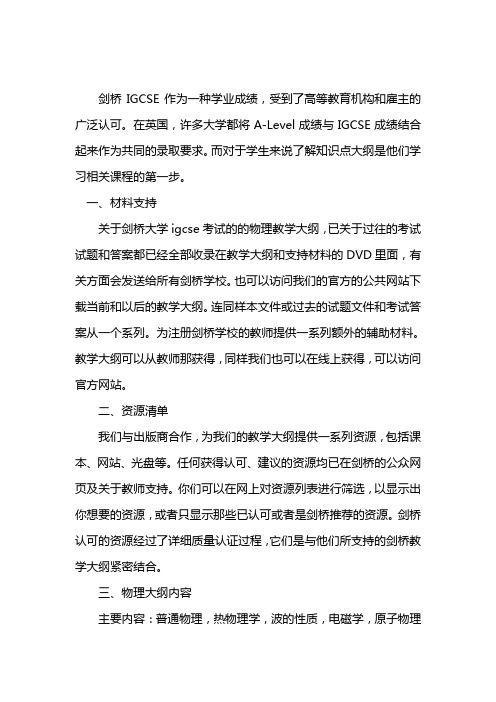
剑桥IGCSE作为一种学业成绩,受到了高等教育机构和雇主的广泛认可。
在英国,许多大学都将A-Level成绩与IGCSE成绩结合起来作为共同的录取要求。
而对于学生来说了解知识点大纲是他们学习相关课程的第一步。
一、材料支持关于剑桥大学igcse考试的的物理教学大纲,已关于过往的考试试题和答案都已经全部收录在教学大纲和支持材料的DVD里面,有关方面会发送给所有剑桥学校。
也可以访问我们的官方的公共网站下载当前和以后的教学大纲。
连同样本文件或过去的试题文件和考试答案从一个系列。
为注册剑桥学校的教师提供一系列额外的辅助材料。
教学大纲可以从教师那获得,同样我们也可以在线上获得,可以访问官方网站。
二、资源清单我们与出版商合作,为我们的教学大纲提供一系列资源,包括课本、网站、光盘等。
任何获得认可、建议的资源均已在剑桥的公众网页及关于教师支持。
你们可以在网上对资源列表进行筛选,以显示出你想要的资源,或者只显示那些已认可或者是剑桥推荐的资源。
剑桥认可的资源经过了详细质量认证过程,它们是与他们所支持的剑桥教学大纲紧密结合。
三、物理大纲内容主要内容:普通物理,热物理学,波的性质,电磁学,原子物理知识点列表:1普通物理1.1长度和时间1.2 速率速度和加速度1.3 质量和重力1.4 密度1.5 力:(a)力的效果,(b)转动效果,(c)平衡条件,(d)重心,(e)标量和矢量1.6 能量能源功和功率1.7 压强2 热物理2.1 分子热运动简单模型:(a)物质的态,(b)分子模型,(c)蒸发,(d)压强的改变2.2 热性质:(a)固体液体气体的热膨胀,(b)温度的测量,(c)热容,(d)熔化和沸腾2.3 热能的传递:(a)热传导,(c)热对流,(d)热辐射,(e)热能传递导致的效果3波的性质3.1 波的一般性质3.2 光:(a)光的反射,(b)光的折射,(c)薄透镜,(d)光的色散,(e)电磁波谱3.3 声波4 电磁学4.1 简单磁现象4.2 电学物理量:(a)电荷,(b)电流,(c)电动势,(d)电压,(e)电阻,(e)电能4.3 电路:(a)电路图,(b)串联,(c)并联,(d)电路元件的作用和使用,(e)数字电路电子学4.4 安全用电和电的危害4.5 电磁效应:(a)电磁感应,(b)交流发电机,(c)变压器,(e)电流的磁效应,(f)通电导体在磁场中受力,(g)直流电动机4.6 阴极射线示波器:(a)阴极射线,(b)阴极射线示波器的简单实用5 原子物理5.1 放射性:(a)放射性探测,(b)三种放射性基本特征,(c)放射性衰变,(d)半衰期,(e)安全事项5.2 原子:(a)原子模型,(b)原子核,(c)同位素学通国际课程培训中心自2008年起一直致力于ALEVEL、IGCSE、IB、AP、SAT2等主流国际课程中30多门科目的提分与培优,经11年深耕教学,目前已拥有教师团队80余人,其中20%为博士,80%为名校海归硕士,平均国际课程教龄8年以上,每年为学生提供50000小时以上的高品质课程。
igcse课程物理笔记

igcse课程物理笔记The IGCSE Physics course covers a wide range of topics, from the basic principles of physics to more complex concepts. IGCSE物理课程涵盖了很多话题,从物理的基本原理到更复杂的概念。
One of the key aspects of the IGCSE Physics course is the focus on practical experiments and investigations. 这门课程的一个关键方面是重点放在实践实验和调查上。
The practical element of the course not only helps students to better understand the theoretical concepts, but also allows them to develop important scientific skills such as observation, analysis, and critical thinking. 课程的实践元素不仅帮助学生更好地理解理论概念,还让他们培养重要的科学技能,如观察、分析和批判性思维。
In addition to practical skills, the IGCSE Physics course also encourages students to develop their mathematical abilities. 除了实践技能,IGCSE物理课程还鼓励学生发展他们的数学能力。
By incorporating mathematical concepts into the study of physics, students are able to make connections between different areas of science and develop a more holistic understanding of the subject. 通过将数学概念融入物理学的学习中,学生能够在不同科学领域之间建立联系,并对科目有更全面的理解。
igcse大纲20232025

IGCSE大纲2023-2025对于全球各地的高中生而言,是一个备受关注的话题。
作为国际通用的中学教育标准,IGCSE大纲的更新往往会影响到全球各地的教学内容和教学质量。
IGCSE大纲2023-2025的发布,意味着新一轮的考试标准和教学内容将会带来哪些变化呢?在本篇文章中,我们将对IGCSE大纲2023-2025进行全面的解读和分析,以帮助读者更好地了解新的教学要求和考试内容。
一、背景介绍IGCSE(国际通用中学教育证书)是由剑桥国际考试委员会(CIE)针对全球各地中学生开设的中学教育课程和考试。
其大纲涵盖了多个学科,涉及自然科学、社会科学、语言文学等多个领域,因此备受全球中学生和教师的关注。
每次IGCSE大纲的更新都会对全球各地的中学教学和考试带来影响,因此备受关注。
二、教学内容的更新1. 学科设置的调整IGCSE大纲2023-2025对学科设置进行了一定的调整,涉及到了自然科学、社会科学、语言文学等多个领域。
在新的大纲中,一些新的学科可能被引入,而一些旧的学科可能会被调整或剔除。
这对于学生和教师来说都意味着需要对课程内容和考试要求进行重新认识和理解。
2. 教学内容的更新新的大纲对于教学内容的要求可能会有所调整。
在自然科学领域,可能会引入新的科学理论和实验内容;在社会科学领域,可能会强调对当代社会问题的认识和理解;在语言文学领域,可能会对文学作品和文学理论进行更新和调整。
这些都将对教师的教学内容和考试准备提出新的要求。
三、考试形式的变化1. 考试方式的调整IGCSE大纲2023-2025可能会对考试方式进行一定的调整。
可能会引入新的考试形式和题型,例如开放式问题、案例分析题等;可能会对考试时间和考试环境进行调整,要求学生在更加真实和复杂的环境下进行考试。
这将对学生的复习和考试准备提出新的挑战。
2. 考试内容的更新新的大纲可能会对考试内容进行一定的更新。
可能会调整考试的重点和难度,并对一些新的领域和新的知识点进行测试;可能会调整考试题型,对学生的综合能力和创新能力进行更加全面和深入的考核。
cie物理大纲

cie物理大纲摘要:一、引言二、CIE 物理大纲概述1.CIE 物理大纲简介2.CIE 物理大纲的主要内容三、CIE 物理大纲的主要特点1.注重理论知识和实践技能的结合2.强调科学素养和批判性思维的培养3.与我国中学物理课程的差异和启示四、CIE 物理大纲对我国中学物理教育的启示1.培养学生科学素养和实践能力2.注重知识体系的整体性和连贯性3.鼓励学生进行批判性思考和创新五、结论正文:一、引言随着全球化的推进,国际间教育交流与合作日益增多。
在我国,越来越多的中学开始关注并引入国际课程,以培养更多具备国际竞争力的优秀人才。
CIE (Cambridge International Examinations)物理大纲作为国际著名课程体系之一,已得到许多我国中学的青睐。
本文将对CIE 物理大纲进行概述,并探讨其对我国中学物理教育的启示。
二、CIE 物理大纲概述1.CIE 物理大纲简介CIE 物理大纲是英国剑桥大学国际考试委员会(Cambridge International Examinations)制定的针对14-16 岁学生的物理课程体系。
该大纲涵盖了力、运动、热、电磁学、现代物理学等基本物理知识领域,以及实验技能和科学研究方法等内容。
2.CIE 物理大纲的主要内容CIE 物理大纲分为两个层次:IGCSE(International General Certificate of Secondary Education,国际普通中等教育证书)和A-Level(Advanced Level,高级水平)。
IGCSE 阶段主要培养学生的基本物理知识和实验技能;A-Level 阶段则进一步深化物理知识,培养学生的独立研究和问题解决能力。
三、CIE 物理大纲的主要特点1.注重理论知识和实践技能的结合CIE 物理大纲强调将物理理论知识和实验技能相结合,使学生在掌握理论知识的同时,培养实际操作能力。
大纲要求学生在学习过程中完成一定数量的实验报告,以锻炼实验设计和数据分析能力。
cie ig物理新考纲

cie ig物理新考纲摘要:1.CIE IGCSE 物理新考纲概述2.新考纲的主要变化3.应对新考纲的策略正文:CIE IGCSE 物理新考纲概述CIE(Cambridge International Examinations)是剑桥大学国际考试委员会,负责举办国际中学教育普通证书(IGCSE)考试。
IGCSE 物理课程旨在为学生提供一个扎实的物理知识基础,培养他们的实验技能、数据分析和解决问题的能力。
本文将介绍CIE IGCSE 物理新考纲的主要内容。
新考纲的主要变化1.知识内容的调整:新考纲对部分知识点进行了调整,以更好地反映物理学科的核心概念。
例如,对力的概念进行了拓展,增加了对牛顿第二定律和动量守恒定律的理解要求。
2.实验技能的强调:新考纲更加强调学生的实验技能,要求学生能够设计实验、收集数据、分析结果,并能对实验结果进行解释。
3.数据分析能力的培养:新考纲要求学生具备较强的数据分析能力,能够运用图表、统计方法对数据进行处理和分析。
4.解决问题的能力:新考纲将培养学生解决问题的能力放在了更加突出的位置,要求学生能够运用所学知识解决实际问题,并能对解决方案进行评估。
应对新考纲的策略1.系统学习物理知识:学生需要对新考纲中的知识点进行系统学习,确保自己对每个知识点有深入的理解。
2.加强实验技能训练:学生应积极参与实验课,提高自己的实验技能,学会设计实验、处理实验数据。
3.提高数据分析能力:学生应掌握基本的数据分析方法,学会运用图表、统计方法对数据进行处理和分析。
4.培养解决问题的能力:学生在学习过程中要注重培养自己的问题解决能力,学会运用所学知识解决实际问题。
总之,CIE IGCSE 物理新考纲对学生的知识掌握、实验技能、数据分析和问题解决能力提出了更高的要求。
上海剑桥国际高中课程

上海剑桥国际高中课程
比较
上海剑桥国际高中课程分为3个层次:IGCSE,A Level和IB。
1. IGCSE (International General Certificate of Secondary Education),国际中学证书,是Cambridge Assessment International Education实施的世界认可的可大规模测试、验证和认证证书。
学生在期末参加考试,考试分为数学、物理、化学、生物地理、历史、政治学、经济学、信息技术等8门课,每门考试合格就可以获得IGCSE证书。
2. A Level (Advanced Level),高级水平课程,是英国研究委员会实施的国际认可的高等教育程度认证。
A Level课程涉及数学、物理、化学、生物、地理、政治学等6门高级科目,期末考试成绩高的学生可以获得由英国教育和研究委员会颁发的A Level证书。
3. IB (International Baccalaureate),国际文凭,是一项全球性的中高等教育文凭系统,具有很高的国际认可性,是由IB组织统一实施和认证的。
学生们在读完6门课程:数学,物理,化学,生物,地理,政治学,以及写作课外,综合核心课,参加期末考试,通过考试可以获得IB文凭。
igcse物理必背公式

igcse物理必背公式(原创版)目录1.IGCSE 物理简介2.IGCSE 物理中的重要概念3.IGCSE 物理必背公式4.公式的应用和例题5.结论正文1.IGCSE 物理简介IGCSE(International General Certificate of Secondary Education)是国际中学教育普通证书,它是目前全球最受欢迎的中学课程之一。
IGCSE 物理是其中一门重要的学科,它旨在帮助学生了解和掌握物理学的基本概念、理论和方法,为后续学习打下坚实的基础。
2.IGCSE 物理中的重要概念IGCSE 物理涉及许多重要的概念,如力、质量、加速度、速度、密度、压强、能量、功率、磁场、电场、电路等。
这些概念是理解物理现象和解决物理问题的关键。
3.IGCSE 物理必背公式在 IGCSE 物理学习中,掌握一些基本的公式至关重要。
以下是一些常见的必背公式:(1)速度、加速度和力的关系:F=ma;v=at;v=u+2as(2)密度和压强的关系:ρ=m/V;P=F/A;P=ρgh(3)功和能的关系:W=Fs;E=W+Q(4)磁场和电场的关系:F=qE;F=qvB(5)电路中的基本公式:I=U/R;P=UI;W=Pt4.公式的应用和例题在学习这些公式时,应用实际例题来巩固理解是非常重要的。
例如,我们可以通过计算物体在给定加速度下的速度和位移,来验证 v=at 和v=u+2as 这两个公式。
同样,在研究电路时,我们可以通过计算电流、电压和功率,来验证 I=U/R、P=UI 和 W=Pt 这些公式。
5.结论总的来说,IGCSE 物理是一门内容丰富且具有挑战性的学科。
要想在这门学科中取得好成绩,掌握基本的概念和公式是至关重要的。
cambridge igcse physics 教材介绍
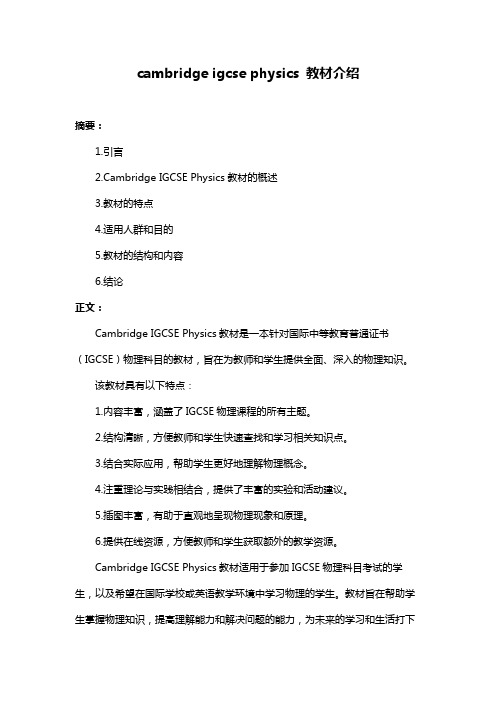
cambridge igcse physics 教材介绍摘要:1.引言2.Cambridge IGCSE Physics教材的概述3.教材的特点4.适用人群和目的5.教材的结构和内容6.结论正文:Cambridge IGCSE Physics教材是一本针对国际中等教育普通证书(IGCSE)物理科目的教材,旨在为教师和学生提供全面、深入的物理知识。
该教材具有以下特点:1.内容丰富,涵盖了IGCSE物理课程的所有主题。
2.结构清晰,方便教师和学生快速查找和学习相关知识点。
3.结合实际应用,帮助学生更好地理解物理概念。
4.注重理论与实践相结合,提供了丰富的实验和活动建议。
5.插图丰富,有助于直观地呈现物理现象和原理。
6.提供在线资源,方便教师和学生获取额外的教学资源。
Cambridge IGCSE Physics教材适用于参加IGCSE物理科目考试的学生,以及希望在国际学校或英语教学环境中学习物理的学生。
教材旨在帮助学生掌握物理知识,提高理解能力和解决问题的能力,为未来的学习和生活打下坚实的基础。
教材的结构和内容如下:1.章节概述:简要介绍本章的主题和内容。
2.主题:按照IGCSE物理课程的要求,分为不同的主题,如力学、热力学、电磁学等。
3.子主题:每个主题下包含若干子主题,详细讲解相关知识点。
4.定义和概念:给出重要物理概念的定义,帮助学生理解和记忆。
5.理论和实践:结合理论知识和实验,加深对物理原理的理解。
6.练习题:提供丰富的练习题,帮助学生巩固所学知识。
7.词汇表:列举本章涉及的重要词汇,方便学生查阅和学习。
总之,Cambridge IGCSE Physics教材是一本优秀的物理教材,适用于国际学校的学生和教师。
igcse物理知识点总结

igcse物理知识点总结IGCSE物理课程是一门广受欢迎的大学准备课程。
它涵盖了机械,电学,声学,热学,光学,时空理论等物理学科,同时包含一些数学和化学课程。
如果学生能掌握IGCSE物理知识点,他们就可以为高等物理知识打下坚实的基础。
IGCSE理知识点凝练地涵盖了以下几大模块:一、机械性能特性1.力:重力是地球上物体之间互相吸引的力量。
2.能:动能是物体移动时所发生的能量。
3.:力是物体之间的动力。
4.昀:物体的状态是指其体积,形状,温度等特性。
5.量:质量是物体移动时产生的量。
二、电学知识点1.流:电流是由电子在导体物质中运动时产生的电流。
2.压:电压是电子在导体物质中运动时产生的电压。
3.阻:电阻是电子在导体物质中移动时产生的阻力。
4.容:电容是电子在一个导体物质中移动时产生的电容量。
5.容电路:电容电路是将电容和电阻元件连接在一起而形成的电路。
三、声学知识点1.音:声音是指多种波状的声波穿越空气,地面,水中的空气。
2.压:声压是指声波在空气中所产生的压力。
3.温:声温是指声波在空气中所产生的温度。
4.振动:声振动是指声波在物体表面上所产生的振动。
5.乐:音乐是指由不同的声音的组合而产生的乐曲。
四、热学1.量:热量是物体表面温度变化所产生的热能。
2.传导:热传导是指热能从一个物体移动到另一个物体的过程。
3.传输:热传输是指热能从一处传播到另一处的过程。
4.容:热容是指物体吸收热量时所产生的热容量。
5.效热:无效热是指物体产生热量但未能传播出去的热量。
五、光学1.:光是由电磁波组成的一种自由行动的能量。
2.彩:色彩是光的不同频率形成的视觉效果。
3.射:反射是指光束从一个物体表面反射回去的过程。
4.射:折射是指光束从一种物质介质到另一种物质介质时,其方向发生改变的过程。
5.焦:聚焦是指光束在物体表面发生改变后,其聚焦点发生变化的过程。
六、时空理论1.量:动量是物体运动时所产生的动量。
2.间:时间是物体交互时所产生的时间差。
国际高中课程三大课程体系解读

国际高中课程三大课程体系解读国际高中课程通常有三个主要的课程体系,分别是:1. 国际文凭课程(IB课程):国际文凭课程是一种涵盖两年的高中课程,涵盖科学、文学、语言、数学和艺术等几个领域,并要求学生积极参与社区服务和体育活动。
IB课程旨在培养学生的跨学科思维能力,以及培养跨文化交流的能力。
在该课程下,学生需要学习6个科目,其中3个为高水平科目,其余3个为标准水平科目,并需要撰写一份长文和参与一个跨学科研究项目。
2. 剑桥国际课程(IGCSE和A-Level):剑桥国际课程(IGCSE和A-Level)是一种广泛学习中英国际学校的课程。
根据学生的不同兴趣和需求提供了多种科目选择,如物理学、化学、生物学、计算机科学、语言、文学以及数学等。
这些课程在国际上非常有名,在英国的大学入学前对学生的申请具有很高的权威性。
课程分为两个阶段:IGCSE在高中的3年级和4年级,A-Level在高中的5年级和6年级。
IGCSE课程要求学生参加多项考试,并从数学、语言、人文科学和实用技能中选择科目。
而A-Level课程则要求学生在少数几个领域深度地研究一个或几个科目,并在考试中得出良好的成绩。
3. AP课程:大学预科课程(AP课程)是一种由美国大学理事会提供的高中学术预备课程,帮助学生养成高水平学术研究、批判性思维和创新观点。
AP有超过30个科目可供选择,包括文学、数学、科学、历史、心理学、计算机科学、音乐、环境科学等。
学生可以选择一到多个科目,并参加对应的考试。
AP课程的考试成绩可以作为学生大学入学申请的参考。
总之,这三种国际高中课程都以其独特的方式为学生提供了一种普遍认可的学习体验,无论学生最终选择学习哪种课程,这些课程都将为他们未来的学术和职业生涯提供很好的基础。
比较好的国际高中课程体系
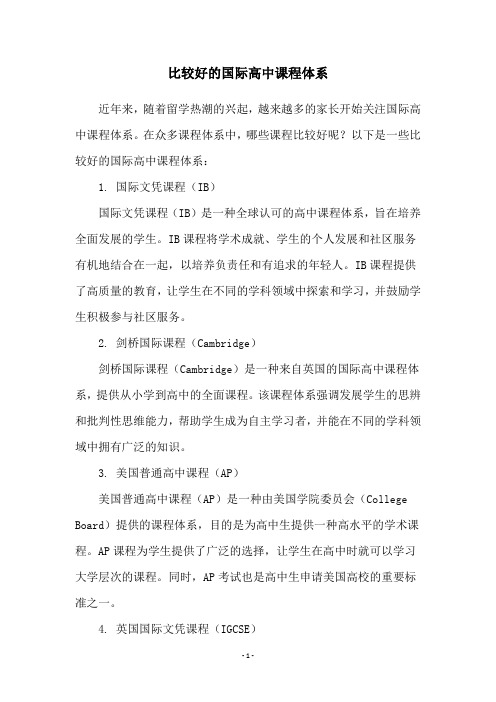
比较好的国际高中课程体系
近年来,随着留学热潮的兴起,越来越多的家长开始关注国际高中课程体系。
在众多课程体系中,哪些课程比较好呢?以下是一些比较好的国际高中课程体系:
1. 国际文凭课程(IB)
国际文凭课程(IB)是一种全球认可的高中课程体系,旨在培养全面发展的学生。
IB课程将学术成就、学生的个人发展和社区服务有机地结合在一起,以培养负责任和有追求的年轻人。
IB课程提供了高质量的教育,让学生在不同的学科领域中探索和学习,并鼓励学生积极参与社区服务。
2. 剑桥国际课程(Cambridge)
剑桥国际课程(Cambridge)是一种来自英国的国际高中课程体系,提供从小学到高中的全面课程。
该课程体系强调发展学生的思辨和批判性思维能力,帮助学生成为自主学习者,并能在不同的学科领域中拥有广泛的知识。
3. 美国普通高中课程(AP)
美国普通高中课程(AP)是一种由美国学院委员会(College Board)提供的课程体系,目的是为高中生提供一种高水平的学术课程。
AP课程为学生提供了广泛的选择,让学生在高中时就可以学习大学层次的课程。
同时,AP考试也是高中生申请美国高校的重要标准之一。
4. 英国国际文凭课程(IGCSE)
英国国际文凭课程(IGCSE)是一种由剑桥国际考试委员会提供的课程体系,是英国中小学课程的国际版。
IGCSE课程既强调学科知识的掌握,又注重培养学生的批判性思维和解决问题的能力。
以上是比较好的国际高中课程体系,每种课程都有其独特的特点和优势。
家长可以根据自己的需求和孩子的特点选择适合自己的课程体系。
igcse物理必考知识点
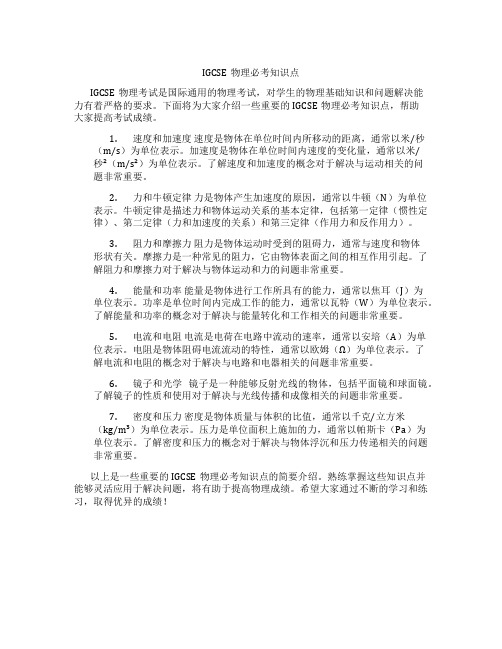
IGCSE物理必考知识点IGCSE物理考试是国际通用的物理考试,对学生的物理基础知识和问题解决能力有着严格的要求。
下面将为大家介绍一些重要的IGCSE物理必考知识点,帮助大家提高考试成绩。
1.速度和加速度速度是物体在单位时间内所移动的距离,通常以米/秒(m/s)为单位表示。
加速度是物体在单位时间内速度的变化量,通常以米/秒²(m/s²)为单位表示。
了解速度和加速度的概念对于解决与运动相关的问题非常重要。
2.力和牛顿定律力是物体产生加速度的原因,通常以牛顿(N)为单位表示。
牛顿定律是描述力和物体运动关系的基本定律,包括第一定律(惯性定律)、第二定律(力和加速度的关系)和第三定律(作用力和反作用力)。
3.阻力和摩擦力阻力是物体运动时受到的阻碍力,通常与速度和物体形状有关。
摩擦力是一种常见的阻力,它由物体表面之间的相互作用引起。
了解阻力和摩擦力对于解决与物体运动和力的问题非常重要。
4.能量和功率能量是物体进行工作所具有的能力,通常以焦耳(J)为单位表示。
功率是单位时间内完成工作的能力,通常以瓦特(W)为单位表示。
了解能量和功率的概念对于解决与能量转化和工作相关的问题非常重要。
5.电流和电阻电流是电荷在电路中流动的速率,通常以安培(A)为单位表示。
电阻是物体阻碍电流流动的特性,通常以欧姆(Ω)为单位表示。
了解电流和电阻的概念对于解决与电路和电器相关的问题非常重要。
6.镜子和光学镜子是一种能够反射光线的物体,包括平面镜和球面镜。
了解镜子的性质和使用对于解决与光线传播和成像相关的问题非常重要。
7.密度和压力密度是物体质量与体积的比值,通常以千克/立方米(kg/m³)为单位表示。
压力是单位面积上施加的力,通常以帕斯卡(Pa)为单位表示。
了解密度和压力的概念对于解决与物体浮沉和压力传递相关的问题非常重要。
以上是一些重要的IGCSE物理必考知识点的简要介绍。
熟练掌握这些知识点并能够灵活应用于解决问题,将有助于提高物理成绩。
- 1、下载文档前请自行甄别文档内容的完整性,平台不提供额外的编辑、内容补充、找答案等附加服务。
- 2、"仅部分预览"的文档,不可在线预览部分如存在完整性等问题,可反馈申请退款(可完整预览的文档不适用该条件!)。
- 3、如文档侵犯您的权益,请联系客服反馈,我们会尽快为您处理(人工客服工作时间:9:00-18:30)。
HOW IS ELECTRIC CURRENT CREATED?
A battery is needed to provide the necessary electro-motive force (e.m.f) to push the charges around the circuit. •A battery has a + terminal and a – terminal, and it will cause (negative charged) electrons to flow from – to +. However, as we think of current as a flow of positive charge, we will define the current as flowing from + to – . This is also called conventional current. •Note here that in the book they often speak of “cell” instead of battery. A cell is simply a electrochemical cell, and batteries are just a collection of electrochemical cells. They can both provide an e.m.f., and do not cause a difference in the physics of the circuit. Nonetheless, separate symbols have been invented to distinguish between a single cell and a battery:
HOW ARE EMF AND CURRENT QUANTIFIED?
RESISTANCE
HOW TO MEASURE CURRENT AND VOLTAGE
How do we measure current? •At any point in the circuit, it is possible to measure the current that goes through that point with an ammeter. You simply connect it in series into the circuit. •Note that for a simple one-loop circuit, the current is the same everywhere. How do we measure voltage? •As current flows through the circuit, it loses energy due to resistance. As such, the current between two different points in a circuit will have a energy difference between them. This difference is called potential difference or voltage between the two points. •We can measure this potential difference in a circuit using a voltmeter. The meter should be placed in parallel with the circuit and connecting the two points.
HOW TO MEASURE RESISTANCE?
IS RESISTANCE CONSTANT?
ELECTRIC ENERR 18:ELECTRICAL QUANTITIES
INTRODUCTION
When electric charges start moving we say that there is a flow of electric current. Of course, electric current can not flow through everything. Materials that conduct electric current well are called conductors while materials that conduct badly are called insulators. In this and the following chapters, we will be concentrating on investigating the flow of electric current in an electric circuit. This is a closed loop network that contains a number of electrical components. In this chapter you will learn: •To explain how electric circuits work using notions of current, resistance, and potential difference. •How to measure and calculate electrical resistance. •How to calculate energy and power in electric circuits.
